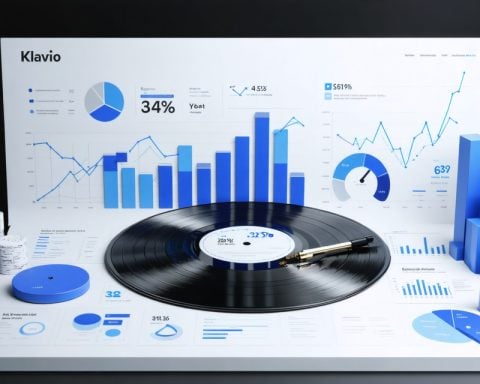- Shopify reports a 26% increase in gross merchandise value, reaching $94.5 billion, and a 31% rise in revenue to $2.81 billion, surpassing forecasts.
- The company’s pivot away from logistics refocuses it on core e-commerce offerings and innovation, enhancing its appeal to a wide range of businesses.
- Shopify Audiences, a marketing tool improving ad performance, stands out as a key factor in attracting merchants and boosting Shopify’s market presence.
- Analysts recognize Shopify’s potential, with positive assessments and upgraded recommendations reflecting confidence in its future growth.
- Despite its premium stock price, Shopify is poised for sustained growth, with projections of continued revenue increases through 2025.
- Investors are faced with the decision of investing in Shopify, a dominant force in the expansive e-commerce sector.
Anticipation crackles around Shopify, the e-commerce titan that has been a beacon of growth for so long it’s easy to forget the challenges it has faced. With the release of its latest earnings report, Shopify proves once more that it thrives in the fast lane. Gross merchandise value leapt 26% to reach a dazzling $94.5 billion in the latest quarter, while revenue shot up by 31% to $2.81 billion, besting forecasts. But what really catches the eye is the company’s swift pivot back to its strengths following a failed venture into logistics.
The heart of Shopify’s continued dominance lies in its relentless innovation. By keeping a firm grip on its core offerings in e-commerce and exploring new horizons, Shopify lures customers ranging from ambitious startups to thriving enterprises. A significant contributor to this success is Shopify Audiences, a marketing tool that fine-tunes ad performance and extends reach, capturing the essence of what merchants need today. This tool exemplifies how Shopify listens and adapts, offering tailored solutions that bolster its clients’ businesses and, in turn, its own bottom line.
Wall Street’s intrigue with Shopify is palpable. Analysts are taking notice, with glowing endorsements and elevated price targets. Yet, one analyst boldly upgraded Shopify to a buy even before earnings were disclosed, highlighting confidence in Shopify Audiences’ potential.
The company’s roadmap is set for continued growth, with steady revenue increases forecasted well into 2025. Despite the premium price of its stock, Shopify stands as a formidable leader in the vast e-commerce landscape. For investors, the lingering question is whether to jump on this speeding train. With momentum like this, the journey with Shopify promises to be exhilarating.
Shopify’s Bright Future: Maximizing E-Commerce Growth and Innovation
How-To Steps & Life Hacks
How to Enhance Your E-Commerce Business with Shopify:
1. Leverage Shopify Audiences: Use Shopify Audiences to target potential customers through finely tuned ad campaigns that increase conversion rates. By analyzing customer data, this tool helps tailor marketing efforts to the most promising demographics.
2. Optimize Your Store Design: Utilize Shopify’s wide array of themes and customization options to create a visually appealing and user-friendly online store. Make sure that your store is mobile-responsive to capture sales from mobile shoppers.
3. Integrate with Third-Party Apps: Enhance functionality with third-party apps from the Shopify App Store to manage inventory, accounting, and marketing more effectively.
4. Utilize Shopify Analytics: Regularly check Shopify’s analytics to track sales, customer behavior, and traffic sources, helping to refine business strategies.
5. Explore New Sales Channels: Take advantage of Shopify’s multi-channel selling capabilities to reach customers via social media, online marketplaces, and physical stores.
Real-World Use Cases
Businesses across various sectors leverage Shopify’s robust platform to scale efficiently. For example, DTC brands find Shopify’s integrated tools essential for managing rapid growth, while traditional retailers use Shopify to boost their online presence and reach global customers.
Market Forecasts & Industry Trends
The e-commerce industry is projected to grow significantly, with global e-commerce sales expected to surpass $7 trillion by 2025. Shopify, as a leading platform, is well-positioned to benefit from this trend due to its focus on innovation and adaptability.
Reviews & Comparisons
Shopify is often compared to competitors like WooCommerce, BigCommerce, and Magento. While Shopify is praised for its ease of use and extensive app ecosystem, others point out the potentially high costs of transaction fees if not using Shopify Payments.
Controversies & Limitations
Some merchants have expressed concerns over Shopify’s pricing model and the additional costs for themes and apps. Furthermore, critics mention Shopify’s limited scalability for extremely large enterprises without significant customization.
Features, Specs & Pricing
Shopify offers several pricing plans:
– Basic Plan: $39/month
– Shopify Plan: $105/month
– Advanced Plan: $399/month
Each plan comes with different features, such as professional reports, additional staff accounts, and advanced report building.
Security & Sustainability
Security is paramount for Shopify, which offers SSL certification, PCI compliance, and fraud analysis tools to keep customer data safe. Shopify also continues to work on sustainability, pledging to power its operations with renewable energy.
Insights & Predictions
As Shopify continues to innovate, expect further enhancements to its AI-driven tools like Shopify Audiences, along with more features supporting omnichannel retail. With an expanding global presence, Shopify aims to cater to a broader range of businesses and consumers.
Tutorials & Compatibility
Shopify offers a plethora of tutorials through its Help Center and community forums, covering everything from store setup to advanced strategies for maximizing sales. Compatible with a wide range of payment gateways, Shopify ensures transactions can be processed seamlessly across borders.
Pros & Cons Overview
Pros:
– User-friendly interface
– Extensive app ecosystem
– Robust analytics and reporting tools
– Excellent customer support
Cons:
– Costs can add up with apps and transaction fees
– Limited customization compared to open-source solutions
Recommendations and Quick Tips
– Tip for New Users: Take advantage of Shopify’s 14-day free trial to explore its features without commitment.
– Advanced Strategy: Experiment with personalized marketing campaigns through Shopify Audiences to improve ROI.
– Store Optimization: Periodically update the site’s images and layout to enhance UX and keep the site fresh.
For more resources and insights, visit Shopify.


















